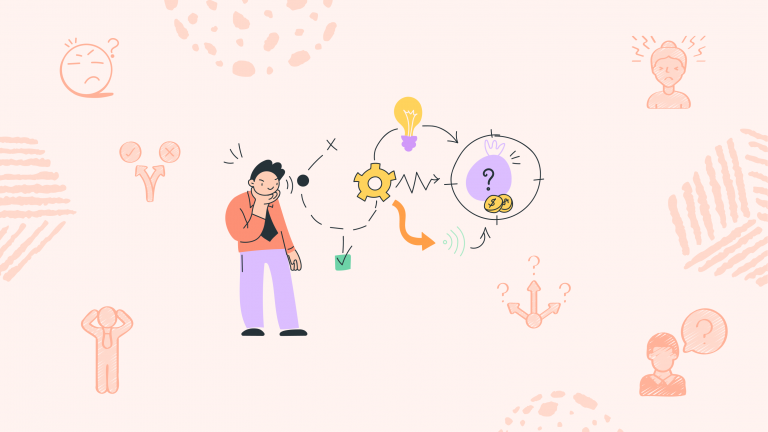Navigate the Sea of Choice Overload
Have you ever felt like you’re trapped in an endless maze of decisions? It’s like every day, life throws a barrage of choices at you, ranging from the mundane (like choosing what to wear) to the monumental (like deciding on a career path). This relentless onslaught can lead to what’s known as decision fatigue, where you’re so bogged down by making choices that it starts to zap your mental energy.
It’s not just the act of choosing that’s draining; it’s the mental load that comes with it. Every decision, no matter how small, forces you to weigh options and consider the outcomes, creating a cocktail of mental and emotional exhaustion. It’s like being a juggler where the balls keep adding up; sooner or later, keeping them all in the air becomes overwhelming.
So, it’s not only about choosing wisely but also about the toll these choices take on your brain. Constantly analyzing and predicting possible futures can make you feel like you’re navigating a minefield, where every step, every decision, is fraught with potential pitfalls. That’s the decision dilemma, where even the most trivial choices start to feel like heavy burdens.
Why Decisions Drain Us
At the core of decision fatigue is the brain’s finite store of mental energy. Making decisions involves the prefrontal cortex, the brain’s command center for executive functions like planning, problem-solving, and controlling impulses. Each decision, no matter how minor, taps into this limited cognitive resource, leading to a diminished capacity to make sound judgments over time.
Neurochemically, decision-making processes deplete glucose levels in the brain, which further reduces our ability to think clearly and control our impulses. As the brain tires, it looks for shortcuts. This might result in impulsive decisions without thorough consideration or, conversely, decision paralysis, where making any choice becomes overwhelming.
Pathways to Decisive Clarity
- Automate Everyday Decisions: Set up routines for repetitive tasks (like having a standard breakfast menu or a weekly wardrobe plan) to minimize the number of choices you need to make each day.
- Prioritize Decisions: Assess the importance of each decision you face and focus on the high-priority ones when you are most alert and refreshed. Use tools like to-do lists or priority matrices to help organize and rank tasks.
- Limit Choices: Whenever possible, reduce the range of options to a manageable few. For example, instead of browsing the entire menu, narrow down to two or three dishes before deciding what to order.
- Schedule Decision-Making Times: Allocate specific times of the day for decision-making tasks, particularly when your cognitive resources are at their peak, to ensure better focus and efficiency.
- Practice Mindfulness: Engage in mindfulness exercises daily to enhance your mental clarity and focus. Regular meditation can help calm your mind and improve your ability to make decisions.
- Take Regular Breaks: Implement short breaks during tasks that require intensive decision-making to prevent mental fatigue and maintain high cognitive function.
- Exercise Gratitude and Reflection: End each day with a moment of gratitude or reflection on the positive outcomes of your decisions, which can help shift perspective and reduce the stress of future decision-making.
- Seek Input When Needed: Don’t hesitate to ask for advice or feedback from trusted friends, family, or colleagues on decisions where you feel stuck, to gain new insights and perspectives.
- Learn from Past Decisions: Reflect on previous decision-making experiences to understand what worked well and what didn’t, helping you improve your decision-making process over time.
- Embrace ‘Good Enough’: Accept that not every decision has to be perfect. Often, opting for a ‘good enough’ choice is sufficient and can alleviate the stress of striving for the best possible outcome in every situation.
Subscribe to newsletter
Get your Gut Health Starter Guide right now.
Elevate your Tuesdays with practical, science-backed wisdom propelling you forward on your gut health journey.

A Story of Renewed Perspective
Michael’s world was once a labyrinth of relentless choices, each turn filled with the daunting question: “What next?” His days blurred into a sequence of decisions, from the professional maze of meetings and emails to the personal spheres of family commitments and lifestyle choices, leaving him perpetually drained and clouded with doubt.
“Every evening, I collapsed into bed, my mind racing with the day’s decisions and the looming ones for tomorrow,” Michael recounts. “The constant state of decision-making was like being adrift in a stormy sea, with waves of choices crashing over me endlessly.”
The shift began with a simple yet profound realization: he needed to streamline his life’s complexities. “I took a step back and started with the basics—meal planning for the week, setting out a simple wardrobe, and creating a morning routine that didn’t require constant choices. These small steps acted like anchors, steadying the ship of my daily life.”
Michael’s strategy extended to his work, where he learned to differentiate between urgent and important tasks, focusing his energies where they were most needed. He introduced regular breaks into his schedule, moments of pause that became islands of calm in his day.
“The transformation was gradual but clear. As the clutter of decisions faded, my vision sharpened. I found a rhythm in the routine, a sense of empowerment in the structure. Decision-making became less of a burden and more of an intentional act,” he reflects.
Michael’s tale is a beacon for those navigating the tumultuous waters of modern life’s choices. “The journey taught me that while I can’t control the number of decisions I face, I can control how I approach them. By simplifying the trivial, I’ve learned to focus on what truly matters, turning the tide of overwhelm into a current that propels me forward.”
In sharing his story, Michael highlights a universal truth: the path to managing decision fatigue is through embracing simplicity and mindfulness. His experience serves as a reminder that with thoughtful strategies and self-awareness, the chaos of choice can be transformed into a structured journey towards a fulfilling and balanced life.


















